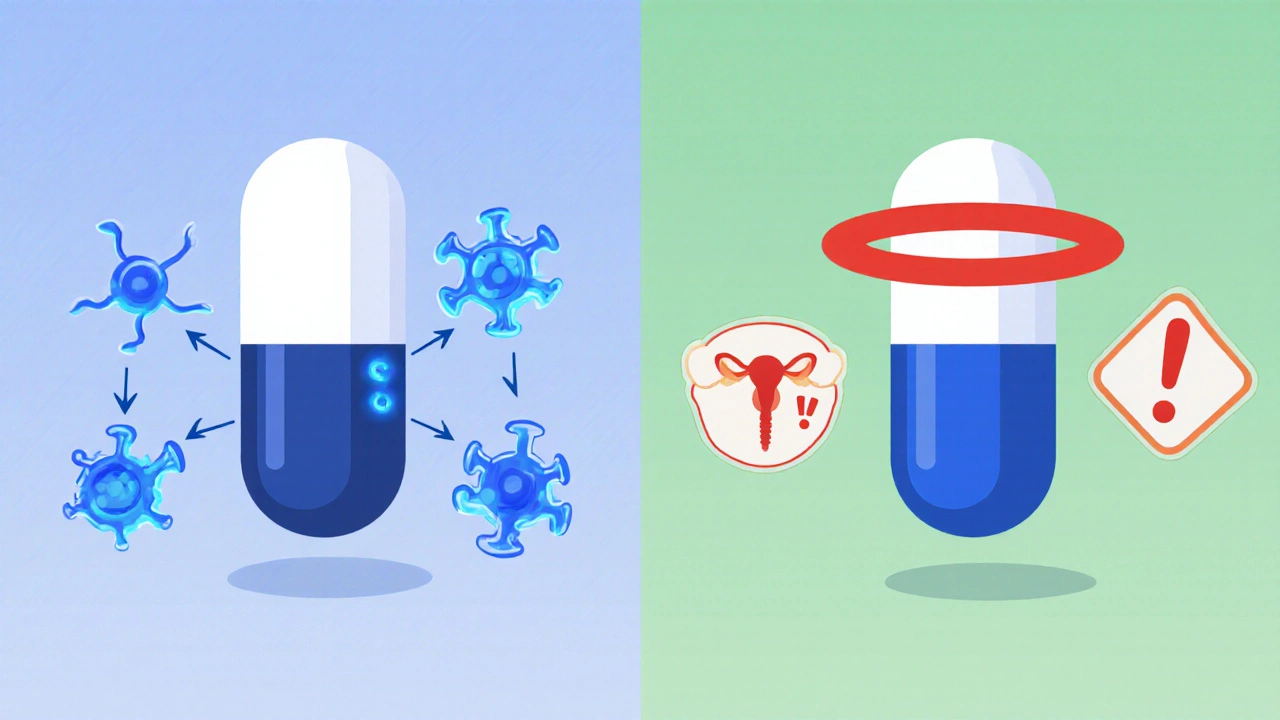Lenalidomide Fertility Calculator & Contraception Guide
Contraception Calculator
Timeline Summary
Contraception Required: At least 14 days before starting lenalidomide
Contraception Duration: Throughout treatment and for 4 weeks after last dose
Pregnancy Testing: Before treatment, monthly during therapy
The FDA requires men to use a condom plus an additional method during treatment and for 4 weeks after stopping lenalidomide.
Results
Contraception Period
Safe Pregnancy Period
Important: All patients must use two reliable forms of contraception during treatment and for 4 weeks after stopping. Pregnancy tests are required before starting and monthly during treatment.
When treating multiple myeloma, Lenalidomide is an immunomodulatory drug (IMiD) that boosts immune cells and blocks new blood‑vessel growth in tumors. It received FDA approval in 2005 and is now a backbone of therapy for myeloma, mantle‑cell lymphoma, and certain myelodysplastic syndromes.
Quick Takeaways
- Lenalidomide is classified as a Category X teratogen - it can cause severe birth defects.
- Both men and women must use reliable contraception before, during, and for at least 4 weeks after stopping the drug.
- Animal studies show dose‑dependent drops in sperm count and impaired ovulation, but human data are limited.
- Pregnancy outcomes reported in clinical trials include miscarriage, stillbirth, and multiple major malformations.
- Guidelines from ASCO, FDA, and EMA stress strict pregnancy‑prevention programs for all patients on lenalidomide.
How Lenalidomide Works - Why It Affects Reproduction
The drug modulates cytokine production, interferes with cereblon (CRBN) binding, and triggers degradation of transcription factors Ikaros and Aiolos. These mechanisms suppress tumor growth but also disrupt normal cellular processes in the gonads. In animal models, CRBN inhibition altered spermatogenesis and folliculogenesis, hinting at a direct toxic effect on germ cells.
Impact on Male Fertility
Human studies are sparse, yet the available data suggest a reversible decline in sperm quality. A 2022 observational cohort of 48 men on lenalidomide reported:
- Mean sperm concentration dropped from 70 million/ml to 35 million/ml after three months of therapy.
- Motility fell from 55% to 30% on average.
- After discontinuation for 12 weeks, 80% of participants recovered to baseline values.
Because the drug’s half‑life is roughly 3 hours, the reproductive toxicity appears linked more to chronic exposure than acute dosing. Nevertheless, the FDA requires men of reproductive potential to use a condom plus an additional contraceptive method throughout treatment.

Impact on Female Fertility
Women experience more pronounced risks due to direct teratogenicity. Lenalidomide can cross the placenta, as shown by a 2021 pharmacokinetic study where fetal plasma levels reached 40% of maternal concentrations. Effects on ovarian function include:
- Reduced anti‑Müllerian hormone (AMH) levels, indicating diminished ovarian reserve.
- Irregular menstrual cycles in 12% of patients after six months of continuous therapy.
- Animal data reveal follicular atresia at doses as low as 5 mg/kg.
While some women regain normal cycles after stopping the drug, the possibility of permanent loss of fertility cannot be dismissed, especially with long‑term use.
Pregnancy Risks - What the Data Show
Lenalidomide is unequivocally a Category X drug. In a pooled analysis of 2,174 patients from Phase II/III myeloma trials, 47 pregnancies were recorded. Outcomes included:
- 28% miscarriage.
- 11% stillbirth.
- 35% live births with major malformations such as limb reduction, cardiac defects, and craniofacial anomalies.
- 26% terminated pregnancies.
These numbers are far higher than the background rate of birth defects (≈3%). The FDA’s Risk Evaluation and Mitigation Strategy (REMS) for lenalidomide mandates a Pregnancy Prevention Program (PPP) for all female patients of child‑bearing potential.
Comparing Lenalidomide with Other IMiDs
Understanding how lenalidomide stacks up against its cousins helps clinicians choose the safest option for patients who wish to preserve fertility.
| Drug | FDA Pregnancy Category | Half‑life | Animal Fertility Findings | Human Fertility Data |
|---|---|---|---|---|
| Lenalidomide | Category X | ≈3 hours | Reduced sperm count, follicular atresia | Reversible sperm decline; possible AMH reduction |
| Thalidomide | Category X | ≈5‑6 hours | Severe limb defects, azoospermia in rats | Well‑documented teratogenicity; limited human fertility data |
| Pomalidomide | Category X | ≈7 hours | Decreased sperm motility, ovarian toxicity in mice | Small case series suggest reversible effects |
All three IMiDs share a high teratogenic potential, but lenalidomide’s shorter half‑life and slightly milder animal fertility impact make it the “least risky” choice-still far from safe for pregnancy.

Guidelines & Contraception Recommendations
Key bodies (FDA, EMA, ASCO) agree on a uniform PPP:
- Women must use two effective contraceptive methods (e.g., hormonal plus barrier) starting at least 14 days before the first dose.
- Men must use a condom plus a second method (e.g., vasectomy or hormonal suppression) throughout treatment.
- Pregnancy testing is required before initiation and monthly thereafter.
- Both partners must continue contraception for at least 4 weeks after the last dose.
- If pregnancy occurs, stop lenalidomide immediately and provide teratology counseling.
Effectiveness of the methods must be documented in the patient’s medical record, and the treating oncologist should review compliance at each visit.
Practical Checklist for Patients on Lenalidomide
- Confirm you are enrolled in a Pregnancy Prevention Program.
- Schedule baseline fertility testing (semen analysis or AMH level) before starting therapy.
- Choose two reliable contraceptives and keep a log of usage.
- Undergo a pregnancy test before the first dose and then every month.
- Report any menstrual changes, testicular pain, or decreased libido promptly.
- If planning to conceive, discuss a drug‑free wash‑out period with your oncologist (minimum 4 weeks).
Frequently Asked Questions
Can men taking lenalidomide father a child?
Yes, but they must use a condom plus an additional reliable method (e.g., vasectomy or hormonal suppression) during treatment and for at least four weeks after stopping the drug. Sperm quality often recovers after a drug‑free interval.
Is lenalidomide safe during early pregnancy?
No. Lenalidomide is a Category X teratogen. Exposure during any trimester has been linked to miscarriage, stillbirth, and serious birth defects. Immediate discontinuation and specialist counseling are required.
How long after stopping lenalidomide can a woman try to conceive?
Guidelines advise waiting at least four weeks after the last dose, provided contraception has been maintained and a negative pregnancy test is confirmed.
Does lenalidomide affect ovarian reserve permanently?
Long‑term data are limited. Some women show a drop in AMH levels that may persist, while others recover after discontinuation. Discuss fertility preservation (egg freezing) before starting therapy if future pregnancy is a priority.
Are there alternative drugs with lower fertility risks?
All approved IMiDs (thalidomide, pomalidomide, lenalidomide) carry Category X warnings. For patients for whom fertility is a top concern, clinicians may consider non‑IMiD regimens such as proteasome inhibitors or monoclonal antibodies, though disease efficacy must be weighed.
Understanding lenalidomide fertility risks empowers patients and clinicians to make informed choices, implement strict contraception, and plan for family building when possible. By following guideline‑driven pregnancy‑prevention programs and monitoring reproductive health, many patients can continue life‑saving therapy while minimizing the chance of a tragic fetal outcome.


Post A Comment